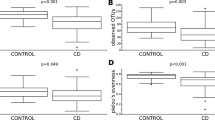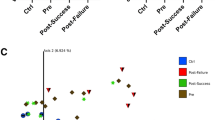Abstract
Background
Patients with inflammatory bowel diseases (IBD) are at risk of micronutrient deficiencies, particularly during flares. Vitamin B6 is required for the proper development of brain, nerves, and many other parts of the body. However, limited studies are available to describe the prevalence, relevance and consequences of vitamin B6 deficiencies in IBD. We aim to estimate the prevalence of vitamin B6 deficiencies in Crohn’s disease (CD) patients, to identify associated risk factors and to explore the alteration of intestinal microbiota related to vitamin B6 status.
Methods
A total of 360 CD patients and 55 ulcerative colitis (UC) patients from Shanghai Tenth People’s Hospital of Tongji University were included. Serum vitamin B6 concentrations were collected from the computerized laboratory data. The logistic regression was used for statistical analysis. Fecal-associated microbiota was also analyzed using 16S rRNA sequencing in another 20 CD patients (10 of vitamin B6 normal, 10 of vitamin B6 deficiency).
Results
The prevalence of vitamin B6 abnormality was significantly higher in CD than in UC patients. Logistic regression analysis showed that small bowel lesion, ileocolonic lesion (L3), extraintestinal manifestations, ileal resection, and usage of immunosuppressor were independently associated with abnormal vitamin B6 in CD. Interestingly, the microbial structure presented significant differences between two CD groups. PICRUSt2 prediction revealed that some enzymes and metabolic pathways between the two groups were significantly different.
Conclusions
Collectively, our analysis showed that vitamin B6 reduction occurred frequently in patients with CD and affected the intestinal flora of patients.
This is a preview of subscription content, access via your institution
Access options
Subscribe to this journal
Receive 12 print issues and online access
$259.00 per year
only $21.58 per issue
Buy this article
- Purchase on Springer Link
- Instant access to full article PDF
Prices may be subject to local taxes which are calculated during checkout






Similar content being viewed by others
Data availability
The 16S rRNA sequencing raw data has been deposited in the NCBI’s Sequence Read Archive database (BioProject: PRJNA867573).
References
Mooney S, Leuendorf JE, Hendrickson C, Hellmann H. Vitamin B6: a long known compound of surprising complexity. Molecules. 2009;14:329–51. https://doi.org/10.3390/molecules14010329.
Saibeni S, Cattaneo M, Vecchi M, Zighetti ML, Lecchi A, Lombardi R, et al. Low vitamin B6 plasma levels, a risk factor for thrombosis, in inflammatory bowel disease: role of inflammation and correlation with acute phase reactants. Am J Gastroenterol. 2003;98:112–7. https://doi.org/10.1111/j.1572-0241.2003.07160.x.
Mittenhuber G. Phylogenetic analyses and comparative genomics of vitamin B6 (pyridoxine) and pyridoxal phosphate biosynthesis pathways. J Mol Microbiol Biotechnol. 2001;3:1–20.
Tanaka T, Tateno Y, Gojobori T. Evolution of vitamin B6 (pyridoxine) metabolism by gain and loss of genes. Mol Biol Evol. 2005;22:243–50. https://doi.org/10.1093/molbev/msi011.
Friso S, Jacques PF, Wilson PW, Rosenberg IH, Selhub J. Low circulating vitamin B6 is associated with elevation of the inflammation marker C-reactive protein independently of plasma homocysteine levels. Circulation. 2001;103:2788–91. https://doi.org/10.1161/01.cir.103.23.2788.
Roubenoff R, Roubenoff RA, Selhub J, Nadeau MR, Cannon JG, Freeman LM, et al. Abnormal vitamin B6 status in rheumatoid cachexia. Association with spontaneous tumor necrosis factor alpha production and markers of inflammation. Arthritis Rheum. 1995;38:105–9. https://doi.org/10.1002/art.1780380116.
Massé PG, Boudreau J, Tranchant CC, Ouellette R, Ericson KL. Type 1 diabetes impairs vitamin B6 metabolism at an early stage of women’s adulthood. Appl Physiol Nutr Metab. 2012;37:167–75. https://doi.org/10.1139/h11-146.
Torres J, Mehandru S, Colombel JF, Peyrin-Biroulet L. Crohn’s disease. Lancet. 2017;389:1741–55. https://doi.org/10.1016/s0140-6736(16)31711-1.
Massironi S, Rossi RE, Cavalcoli FA, Della Valle S, Fraquelli M, Conte D. Nutritional deficiencies in inflammatory bowel disease: therapeutic approaches. Clin Nutr. 2013;32:904–10. https://doi.org/10.1016/j.clnu.2013.03.020.
Vagianos K, Bector S, McConnell J, Bernstein CN. Nutrition assessment of patients with inflammatory bowel disease. JPEN J Parenter Enter Nutr. 2007;31:311–9. https://doi.org/10.1177/0148607107031004311.
Kuroki F, Iida M, Tominaga M, Matsumoto T, Hirakawa K, Sugiyama S, et al. Multiple vitamin status in Crohn’s disease. Correlation with disease activity. Dig Dis Sci. 1993;38:1614–8. https://doi.org/10.1007/bf01303168.
Amir A, McDonald D, Navas-Molina JA, Kopylova E, Morton JT, Zech Xu Z, et al. Deblur rapidly resolves single-nucleotide community sequence patterns. mSystems. 2017;2. https://doi.org/10.1128/mSystems.00191-16.
Quast C, Pruesse E, Yilmaz P, Gerken J, Schweer T, Yarza P, et al. The SILVA ribosomal RNA gene database project: improved data processing and web-based tools. Nucleic Acids Res. 2013;41:D590–6. https://doi.org/10.1093/nar/gks1219.
Schloss PD, Westcott SL, Ryabin T, Hall JR, Hartmann M, Hollister EB, et al. Introducing mothur: open-source, platform-independent, community-supported software for describing and comparing microbial communities. Appl Environ Microbiol. 2009;75:7537–41. https://doi.org/10.1128/aem.01541-09.
Caporaso JG, Kuczynski J, Stombaugh J, Bittinger K, Bushman FD, Costello EK, et al. QIIME allows analysis of high-throughput community sequencing data. Nat Methods. 2010;7:335–6. https://doi.org/10.1038/nmeth.f.303.
Lozupone CA, Hamady M, Kelley ST, Knight R. Quantitative and qualitative beta diversity measures lead to different insights into factors that structure microbial communities. Appl Environ Microbiol. 2007;73:1576–85. https://doi.org/10.1128/aem.01996-06.
Lozupone C, Knight R. UniFrac: a new phylogenetic method for comparing microbial communities. Appl Environ Microbiol. 2005;71:8228–35. https://doi.org/10.1128/aem.71.12.8228-8235.2005.
Segata N, Izard J, Waldron L, Gevers D, Miropolsky L, Garrett WS, et al. Metagenomic biomarker discovery and explanation. Genome Biol. 2011;12:R60. https://doi.org/10.1186/gb-2011-12-6-r60.
Mandrekar JN. Receiver operating characteristic curve in diagnostic test assessment. J Thorac Oncol. 2010;5:1315–6. https://doi.org/10.1097/JTO.0b013e3181ec173d.
Shannon P, Markiel A, Ozier O, Baliga NS, Wang JT, Ramage D, et al. Cytoscape: a software environment for integrated models of biomolecular interaction networks. Genome Res. 2003;13:2498–504. https://doi.org/10.1101/gr.1239303.
Douglas GM, Maffei VJ, Zaneveld JR, Yurgel SN, Brown JR, Taylor CM, et al. PICRUSt2 for prediction of metagenome functions. Nat Biotechnol. 2020;38:685–8. https://doi.org/10.1038/s41587-020-0548-6.
Kanehisa M, Goto S. KEGG: kyoto encyclopedia of genes and genomes. Nucleic Acids Res. 2000;28:27–30. https://doi.org/10.1093/nar/28.1.27.
Caspi R, Billington R, Keseler IM, Kothari A, Krummenacker M, Midford PE, et al. The MetaCyc database of metabolic pathways and enzymes - a 2019 update. Nucleic Acids Res. 2020;48:D445–53. https://doi.org/10.1093/nar/gkz862.
Magnúsdóttir S, Ravcheev D, de Crécy-Lagard V, Thiele I. Systematic genome assessment of B-vitamin biosynthesis suggests co-operation among gut microbes. Front Genet. 2015;6:148. https://doi.org/10.3389/fgene.2015.00148.
Ulvik A, Midttun Ø, Pedersen ER, Eussen SJ, Nygård O, Ueland PM. Evidence for increased catabolism of vitamin B-6 during systemic inflammation. Am J Clin Nutr. 2014;100:250–5. https://doi.org/10.3945/ajcn.114.083196.
Pittayanon R, Lau JT, Leontiadis GI, Tse F, Yuan Y, Surette M, et al. Differences in gut microbiota in patients with vs without inflammatory bowel diseases: a systematic review. Gastroenterology. 2020;158:930–46.e931. https://doi.org/10.1053/j.gastro.2019.11.294.
Hedin CR, McCarthy NE, Louis P, Farquharson FM, McCartney S, Taylor K, et al. Altered intestinal microbiota and blood T cell phenotype are shared by patients with Crohn’s disease and their unaffected siblings. Gut. 2014;63:1578–86. https://doi.org/10.1136/gutjnl-2013-306226.
Mulligan JH, Snell EE. Transport and metabolism of vitamin B6 in lactic acid bacteria. J Biol Chem. 1977;252:835–9.
Sokol H, Pigneur B, Watterlot L, Lakhdari O, Bermúdez-Humarán LG, Gratadoux JJ, et al. Faecalibacterium prausnitzii is an anti-inflammatory commensal bacterium identified by gut microbiota analysis of Crohn disease patients. Proc Natl Acad Sci USA. 2008;105:16731–6. https://doi.org/10.1073/pnas.0804812105.
Lavelle A, Sokol H. Gut microbiota-derived metabolites as key actors in inflammatory bowel disease. Nat Rev Gastroenterol Hepatol. 2020;17:223–37. https://doi.org/10.1038/s41575-019-0258-z.
Arpaia N, Campbell C, Fan X, Dikiy S, van der Veeken J, deRoos P, et al. Metabolites produced by commensal bacteria promote peripheral regulatory T-cell generation. Nature. 2013;504:451–5. https://doi.org/10.1038/nature12726.
Maslowski KM, Vieira AT, Ng A, Kranich J, Sierro F, Yu D, et al. Regulation of inflammatory responses by gut microbiota and chemoattractant receptor GPR43. Nature. 2009;461:1282–6. https://doi.org/10.1038/nature08530.
Li G, Lin J, Zhang C, Gao H, Lu H, Gao X, et al. Microbiota metabolite butyrate constrains neutrophil functions and ameliorates mucosal inflammation in inflammatory bowel disease. Gut Microbes. 2021;13:1968257. https://doi.org/10.1080/19490976.2021.1968257.
Sun M, Wu W, Chen L, Yang W, Huang X, Ma C, et al. Microbiota-derived short-chain fatty acids promote Th1 cell IL-10 production to maintain intestinal homeostasis. Nat Commun. 2018;9:3555. https://doi.org/10.1038/s41467-018-05901-2.
Kaiko GE, Ryu SH, Koues OI, Collins PL, Solnica-Krezel L, Pearce EJ, et al. The colonic crypt protects stem cells from microbiota-derived metabolites. Cell. 2016;165:1708–20. https://doi.org/10.1016/j.cell.2016.05.018.
Koh A, De Vadder F, Kovatcheva-Datchary P, Bäckhed F. From dietary fiber to host physiology: short-chain fatty acids as key bacterial metabolites. Cell. 2016;165:1332–45. https://doi.org/10.1016/j.cell.2016.05.041.
Rosenberg J, Ischebeck T, Commichau FM. Vitamin B6 metabolism in microbes and approaches for fermentative production. Biotechnol Adv. 2017;35:31–40. https://doi.org/10.1016/j.biotechadv.2016.11.004.
Acknowledgements
The authors are grateful to the participants for their involvement in the survey.
Funding
This work was supported by grants from the National Natural Science Foundation of China (82070562, 9194230064, 91942312 and 81800486) and the Shanghai Rising-Star Program (20QA1407700).
Author information
Authors and Affiliations
Contributions
Data collation, statistical analysis and paper writing, ZF, JH and FG; data collection, paper revision, guidance, YZ and WW; research design, funding support, paper revision and review, ZL and WW. All authors have read and agreed to the published version of the manuscript.
Corresponding authors
Ethics declarations
Competing interests
The authors declare no competing interests.
Ethics approval and consent to participate
The study was conducted in accordance with the Declaration of Helsinki, and the protocol was approved by the Institutional Review Board for Clinical Research of the Shanghai Tenth People’s Hospital of Tongji University. Informed consent was obtained from all subjects involved in the study.
Additional information
Publisher’s note Springer Nature remains neutral with regard to jurisdictional claims in published maps and institutional affiliations.
Supplementary information
Rights and permissions
Springer Nature or its licensor (e.g. a society or other partner) holds exclusive rights to this article under a publishing agreement with the author(s) or other rightsholder(s); author self-archiving of the accepted manuscript version of this article is solely governed by the terms of such publishing agreement and applicable law.
About this article
Cite this article
Feng, Z., Hua, J., Guo, F. et al. A retrospective analysis of vitamin B6 deficiency and associated changes of gut microbes in Crohn’s disease. Eur J Clin Nutr 77, 1034–1043 (2023). https://doi.org/10.1038/s41430-023-01324-5
Received:
Revised:
Accepted:
Published:
Issue Date:
DOI: https://doi.org/10.1038/s41430-023-01324-5



